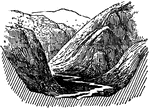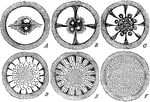Clipart tagged: ‘furrow’
Furrow Method
"Showing Furrow Method of Irrigating Potatoes. The arrows indicate the direction taken by the capillary…

Marking-stick
"For very small beds, drills, or furrows may be made by a simple marking-stick." — Baily, 1898

Valley
If land falls to a minimum line with a steady slope, the land form created is called a valley.

The Segmentation of the Vitellus
"The first change in the parent-cell is that by which it becomes broken up into a mass of cells, each…